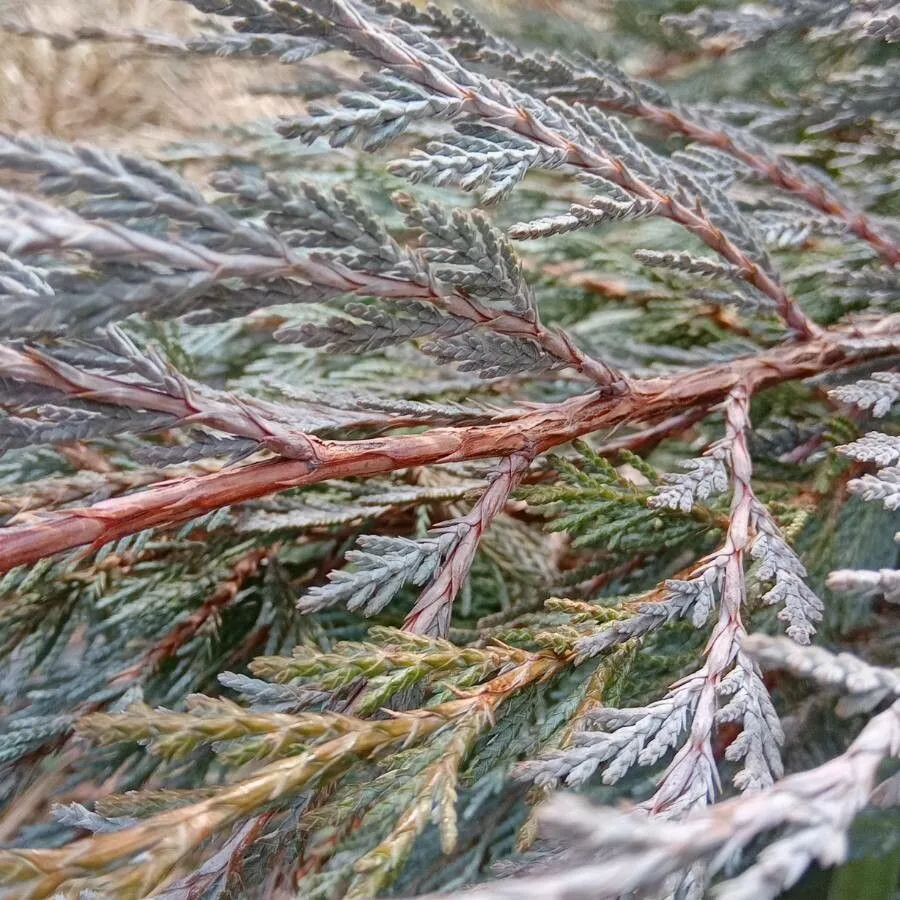
Author: Sarg.
Bibliography: Gard. & Forest 10: 420 (1897)
Year: 1897
Status: accepted
Rank: species
Genus: Juniperus
Vegetable: False
Observations: W. Canada to N. Mexico
The Rocky Mountain red-cedar, scientifically known as Juniperus scopulorum, is an intriguing member of the Cupressaceae family, demonstrating a wealth of resilience and adaptability in its native habitats. This evergreen tree graces a range of landscapes across western Canada down to northern Mexico, thriving in diverse environments and elevations, a testament to its hardy nature.
An article published in Gard. & Forest in 1897 by author Sarg. provides an in-depth look at this species, underscoring its botanical significance and historical context. The Rocky Mountain red-cedar is distinguished by its dense, conical form and lush, bluish-green foliage, which exudes a subtle, fragrant aroma. The tree’s bark is notably thin, shedding in long, fibrous strips, and revealing a reddish-brown inner layer that contributes to its common name.
Throughout its expansive range, from the rippling hills and mountainous terrains to arid regions, the Rocky Mountain red-cedar demonstrates remarkable versatility. It often inhabits rocky ridges, slopes, and well-drained soils, illustrating a preference for elevated terrains. These trees typically reach heights of up to 15 meters, although in optimal conditions, they can grow even taller.
The reproductive characteristics of Juniperus scopulorum are equally fascinating, with separate male and female trees producing distinct types of cones. The female trees yield berry-like cones, which mature to a dark blue or black color, often serving as a food source for various bird species. The male trees produce smaller, yellowish pollen cones. Pollination is primarily facilitated by the wind, ensuring the continuous propagation of this species.
In addition to its ecological contributions, the Rocky Mountain red-cedar holds cultural and practical significance. Indigenous peoples and early settlers have long utilized its durable wood for various purposes, from constructing shelters to crafting tools and ceremonial items. Today, it continues to be valued in landscaping and horticulture for its aesthetic appeal and low maintenance requirements.
The Rocky Mountain red-cedar is more than just a plant; it is a symbol of resilience and adaptability in the diverse ecosystems it inhabits. Its presence enriches the environment, offers habitat and food for wildlife, and carries a legacy of use and appreciation by humans through generations.
Deu: felsengebirgs-wacholder
Ita: ginepro delle montagne rocciose
Eng: red-cedar, river juniper, rocky mountain juniper, rocky mountain red-cedar, rocky mountain red cedar, western juniper
Hun: sziklás-hegységi boróka
Spa: cedro rojo, enebro riparío
Fra: genévrier des montagnes rocheuses, genévrier des rocheuses
Por: junipero-das-montanhas-rochosas
Swe: röd-en, röden
En: Rocky Mountain red-cedar, River juniper, Rocky Mountain juniper, Red-cedar, Rocky Mountain red cedar, Western juniper
Fr: Genévrier des Montagnes Rocheuses, Genévrier des Rocheuses
De: Felsengebirgs-Wacholder
Hu: Sziklás-hegységi boróka
It: Ginepro delle Montagne Rocciose
Pt: Junipero-das-montanhas-rochosas
Es: Cedro rojo, Enebro riparío
Sv: Röd-en, Röden
: Rocky mountain juniper
Taken Nov 19, 2022 by melachis (cc-by-sa)
Taken Feb 5, 2021 by da Ponte Cristina (cc-by-sa)
Taken Oct 27, 2021 by Pieter Verbrugghe (cc-by-sa)
Taken Jun 30, 2022 by Chmelik Jan (cc-by-sa)
Taken Sep 16, 2021 by Игорь Бунин (cc-by-sa)
Taken Nov 11, 2022 by Monteiro Henrique (cc-by-sa)
Taken Sep 23, 2020 by fabrizio (cc-by-sa)
Taken Nov 13, 2022 by Blue Bottle (cc-by-sa)
Taken Jun 21, 2022 by Игорь Бунин (cc-by-sa)
Taken Feb 13, 2022 by Вера Ларюшкина (cc-by-sa)
Taken May 21, 2022 by ren m (cc-by-sa)
Taken Jun 7, 2020 by Iepikhin Dmitriy (cc-by-sa)
Taken Oct 31, 2020 by Pascal Vuylsteker (cc-by-sa)
Taken Feb 5, 2021 by da Ponte Cristina (cc-by-sa)
Taken Aug 5, 2022 by brittanie benavidez (cc-by-sa)
Taken Nov 11, 2022 by Monteiro Henrique (cc-by-sa)
Taken Jan 1, 1900 by EOL − USDA-NRCS PLANTS Database / Herman, D.E. et al. 1996. North Dakota tree handbook. USDA NRCS ND State Soil Conservation Committee; NDSU Extension and Western Area Power Admin., Bismarck, ND. (public)
Taken Apr 27, 2022 by emine Ayazoğlu (cc-by-sa)
Taken Feb 5, 2021 by da Ponte Cristina (cc-by-sa)
Taken Sep 20, 2020 by Olivier Lescure (cc-by-sa)
Taken Mar 15, 2005 by Photoflora – Jean-Luc TASSET (©)
Taken Mar 15, 2005 by Photoflora – Jean-Luc TASSET (©)
© copyright of the Board of Trustees of the Royal Botanic Gardens, Kew.
Growth form>: Stoloniferous
Growth habit>: Tree, Shrub
Growth rate>: Slow
Ph maximum: 8.5
Ph minimum: 5.0
Family: Myrtaceae Author: (F.Muell.) K.D.Hill & L.A.S.Johnson Bibliography: Telopea 6: 402 (1995) Year: 1995 Status:…
Family: Rubiaceae Author: Pierre ex A.Froehner Bibliography: Notizbl. Bot. Gart. Berlin-Dahlem 1: 237 (1897) Year:…
Family: Sapindaceae Author: Koidz. Bibliography: J. Coll. Sci. Imp. Univ. Tokyo 32(1): 38 (1911) Year:…
Family: Asteraceae Author: A.Gray Bibliography: Pacif. Railr. Rep.: 107 (1857) Year: 1857 Status: accepted Rank:…
Family: Fabaceae Author: Medik. Bibliography: Vorles. Churpfälz. Phys.-Ökon. Ges. 2: 398 (1787) Year: 1787 Status:…
Family: Aspleniaceae Author: (Cav.) Alston Bibliography: Bull. Misc. Inform. Kew 1932: 309 (1932) Year: 1932…